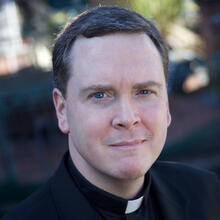The largest copyrighted work of art on the planet is the “Rainbow Swash,” six giant streaks of brightly colored paint on an LNG gas tank, a 140-foot tall steel container located on the eastern side of Boston’s Southeast Expressway. Completed in 1971, “Rainbow Swash” is the biggest and most famous work of the artist-cum-activist Sister Mary Corita, the “rebel nun” who “broke new artistic ground during an era when opportunities were limited for women.” As Barbara Curtain Miles rightly observes in this issue, Corita, as she was known after her departure from religious life in 1968, “deserves recognition alongside her famous secular counterpart, the pop artist Andy Warhol.”
Most of the thousands of people who drive by the tank each day make a quick, “isn’t-that-nice” nod to this now revered Boston icon, yet they are largely unaware of the controversy that has long surrounded it. For if you look carefully at the left side of its blue streak, you will see, according to not a few Bostonians, the profile of an old man with a long beard who looks too suspiciously like Ho Chi Minh, the North Vietnamese Communist leader and bête noire of successive U.S. presidents. True, Corita was a pacifist who opposed the Vietnam War, but she always denied that she had embedded such an image in the work. That fact, however, has not stopped people, especially those who took a more hawkish view of the American misadventure in Vietnam, from seeing Ho in it anyway.
I drove past the LNG tank for years and never saw the image, so one morning I decided to take a closer look. I parked my car on the side of the expressway and stared, squinting and contorting my eyes, at Corita’s blue streak for the better part of 20 minutes. To my amazement, just as I was about to give up, I did see clearly the left profile of an old man with a long beard. I saw Ho. But had I really seen him, or was I merely imposing Ho on Corita? And even if it is a profile of a man, how do we know that it’s Ho Chi Minh and not, say, ZZ Top? More important, what if it’s just a few random strokes of the artist’s brush? It still seems incoherent that a person so committed to abstract art would make such a literal statement in her largest commission. So while I have seen Ho in the streak and I always will see him, I’m not convinced that I ever did or ever will.
Which brings me to the meeting of the Synod of Bishops underway in Rome. Pope Francis has made it clear that the synod is meeting to consider the church’s pastoral response to the graces and challenges of contemporary family life in a spirit of openness and renewal. Above all, as the pope said in this magazine two years ago, he believes that “consultation is very important. The consistories [of cardinals], the synods [of bishops] are, for example, important places to make real and active this consultation. We must, however, give them a less rigid form. I do not want token consultations, but real consultations.” Francis also warned the synod fathers this week to avoid a “hermeneutic of suspicion” that prompts one to see skullduggery and manipulation in every quarter. The pope’s words, unfortunately, have not prevented some participants on every side from seeing precisely that. As Cardinal Donald Wuerl remarked last week, “If you’re convinced this is all rigged, then you’re going to see that everywhere.” In other words, if you are looking for Ho, you’re likely to find him.
Pope Francis has made it clear: The synodal process is complex, it’s messy, but it isn’t rigged. There is no Ho there. I believe him. Then again, I think I believe Corita too.








